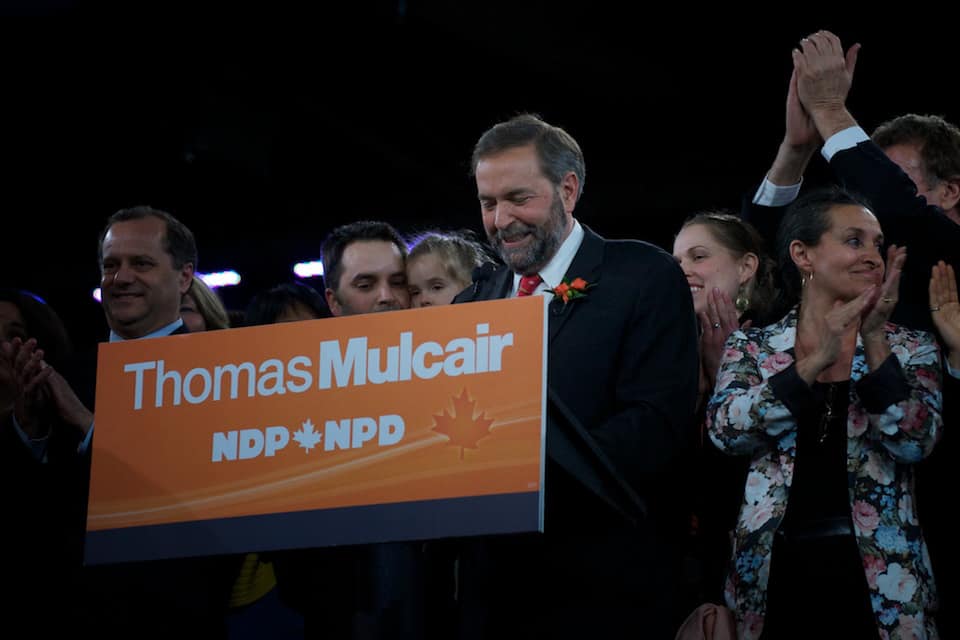[dropcap]In[/dropcap] this election, Canada has been swept by the red tide — the Liberals rose from third party status in the beginning of the election to winning 184 out of 338 seats and a majority government. This victory was, in part, a result of strong desire to oust Harper’s Conservatives. Yet, there was more than one way for voters to reject the incumbent, and the New Democrats were actually leading in the polls during August. What accounts for the NDP’s return to third party status, with only 19.7 per cent of the popular vote for 44 seats?
Many lament the NDP’s loss of seats as a negative consequence of strategic voting, which encouraged citizens to vote for whichever non-Conservative party was leading in their riding. Offhand, it is certainly conceivable that this idea swung some voters from the NDP to the Liberals. However, the Liberals could hardly have beaten the NDP due to strategic voting unless they were already beating them in the first place.
This was by no means a given at the beginning of the campaign. The Liberals started the election with only 10 per cent of the House’s seats, and had 18.9 per cent of the 2011 popular vote compared to the NDP’s 30.6 per cent. Additionally, the Liberals were clearly in a steady third place in this election’s early opinion polls. So how did the NDP lose enough ground to the Liberals for strategic voting to even become relevant?
‘It’s the economy, stupid’ goes the democratic truism that Mr. Mulcair would have done well to remember. Beginning with the leaders’ debate on economic issues, on September 17, the NDP took a fiscal line that few of their supporters would have imagined in August. Committing to austerity by pledging to balance the budget for every year of their hypothetical government, the NDP placed their platform closer to the Conservatives than anything that could be termed ‘progressive.’ Mr. Mulcair would go on to frequently bill his party as “The party of Tommy Douglas’s 17 balanced budgets in a row” in interviews.
Even more uncharacteristically, the NDP committed to no changes to federal income tax rates. Supporters who expected the traditional party of the radical left to deliver more redistribution of wealth from the richest Canadians to the rest were disappointed.
[pullquote]Even more uncharacteristically, the NDP committed to no changes to federal income tax rates.[/pullquote]
It is with the Liberals that these centre-left swing voters found solace. Surprisingly moving to the left, the Liberals proposed a new tax rate of 33 per cent on income of more than $200,000, as well as a tax break on the middle class income bracket. This is not to mention their commitment to running a deficit in order to restore economic security.
Centre-left observers ought to remember that economics, traditionally more popularly a talking point among conservatives, are more than just digits on balance sheets and inscrutable graphs. Full-time jobs feed the families of ordinary people, and GDP growth decides how much the country is able to share in order to improve people’s lives. In a Canada entering into a recession, while our peers stride along relatively healthily, the NDP seemed to ignore the country’s steadily rising 7.1 per cent unemployment rate, anemic one per cent projected annual growth, of our plummeting dollar.
As Mr. Harper steps down from the leadership and the Conservative party re-evaluates its direction, the NDP must re-evaluate its soul. The party of the late Mr. Layton must decide why it embraced austerity under trying economic conditions, and when faced with its most realistic chance in history of forming the federal government, why it decided to avoid talk of raising taxes on the rich and cutting them for low- and middle-income Canadians. Equally, every NDP supporter should be asking what their party stands for if it abandoned socialism when ordinary Canadians wanted it more than ever. Only then will the party be able to recover from its immense losses this election.
Theodore Yan is a fourth-year student at New College studying political science.
Correction (October 27, 2015): An earlier version of this article said that the New Democrats were second in the polls in the beginning. In fact, the New Democrats were leading in the polls during August.


